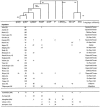Y-chromosome evidence for differing ancient demographic histories in the Americas
- PMID: 12900798
- PMCID: PMC1180678
- DOI: 10.1086/377588
Y-chromosome evidence for differing ancient demographic histories in the Americas
Abstract
To scrutinize the male ancestry of extant Native American populations, we examined eight biallelic and six microsatellite polymorphisms from the nonrecombining portion of the Y chromosome, in 438 individuals from 24 Native American populations (1 Na Dené and 23 South Amerinds) and in 404 Mongolians. One of the biallelic markers typed is a recently identified mutation (M242) characterizing a novel founder Native American haplogroup. The distribution, relatedness, and diversity of Y lineages in Native Americans indicate a differentiated male ancestry for populations from North and South America, strongly supporting a diverse demographic history for populations from these areas. These data are consistent with the occurrence of two major male migrations from southern/central Siberia to the Americas (with the second migration being restricted to North America) and a shared ancestry in central Asia for some of the initial migrants to Europe and the Americas. The microsatellite diversity and distribution of a Y lineage specific to South America (Q-M19) indicates that certain Amerind populations have been isolated since the initial colonization of the region, suggesting an early onset for tribalization of Native Americans. Age estimates based on Y-chromosome microsatellite diversity place the initial settlement of the American continent at approximately 14,000 years ago, in relative agreement with the age of well-established archaeological evidence.
Figures





Similar articles
-
The dual origin and Siberian affinities of Native American Y chromosomes.Am J Hum Genet. 2002 Jan;70(1):192-206. doi: 10.1086/338457. Epub 2001 Nov 30. Am J Hum Genet. 2002. PMID: 11731934 Free PMC article.
-
The first peopling of South America: new evidence from Y-chromosome haplogroup Q.PLoS One. 2013 Aug 21;8(8):e71390. doi: 10.1371/journal.pone.0071390. eCollection 2013. PLoS One. 2013. PMID: 23990949 Free PMC article.
-
American Indian prehistory as written in the mitochondrial DNA: a review.Hum Biol. 1992 Jun;64(3):403-16. Hum Biol. 1992. PMID: 1351474
-
The late Pleistocene dispersal of modern humans in the Americas.Science. 2008 Mar 14;319(5869):1497-502. doi: 10.1126/science.1153569. Science. 2008. PMID: 18339930 Review.
-
Late Pleistocene exploration and settlement of the Americas by modern humans.Science. 2019 Jul 12;365(6449):eaat5447. doi: 10.1126/science.aat5447. Science. 2019. PMID: 31296740 Review.
Cited by
-
Evolutionary responses to a constructed niche: ancient Mesoamericans as a model of gene-culture coevolution.PLoS One. 2012;7(6):e38862. doi: 10.1371/journal.pone.0038862. Epub 2012 Jun 21. PLoS One. 2012. PMID: 22768049 Free PMC article.
-
Continent-wide decoupling of Y-chromosomal genetic variation from language and geography in native South Americans.PLoS Genet. 2013 Apr;9(4):e1003460. doi: 10.1371/journal.pgen.1003460. Epub 2013 Apr 11. PLoS Genet. 2013. PMID: 23593040 Free PMC article.
-
Recent developments in genomewide association scans: a workshop summary and review.Am J Hum Genet. 2005 Sep;77(3):337-45. doi: 10.1086/432962. Epub 2005 Aug 1. Am J Hum Genet. 2005. PMID: 16080110 Free PMC article. Review.
-
Problematic use of Greenberg's linguistic classification of the Americas in studies of Native American genetic variation.Am J Hum Genet. 2004 Sep;75(3):519-22. doi: 10.1086/423452. Am J Hum Genet. 2004. PMID: 15284953 Free PMC article. No abstract available.
-
Genetic background and climatic droplet keratopathy incidence in a Mapuche population from Argentina.PLoS One. 2013 Sep 5;8(9):e74593. doi: 10.1371/journal.pone.0074593. eCollection 2013. PLoS One. 2013. PMID: 24040292 Free PMC article.
References
-
- Bergen AW, Wang CY, Tsai J, Jefferson K, Dey C, Smith KD, Park SC, Tsai SJ, Goldman D (1999) An Asian-Native American paternal lineage identified by RPS4Y resequencing and by microsatellite haplotyping. Ann Hum Genet 63:63–80 - PubMed
-
- Bianchi N, Bailliet G, Brave CM, Pena SD, Rothhammer F (1997) Origin of Amerindian Y-chromosome as inferred by the analysis of six polymorphic markers. Am J Phys Anthropol 102:79–89 - PubMed
Publication types
MeSH terms
Substances
Grants and funding
LinkOut - more resources
Full Text Sources

